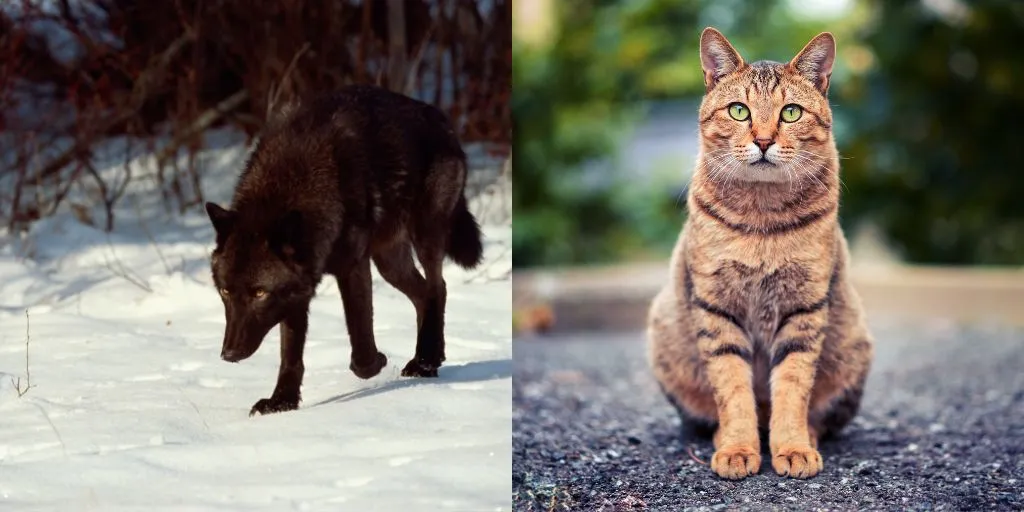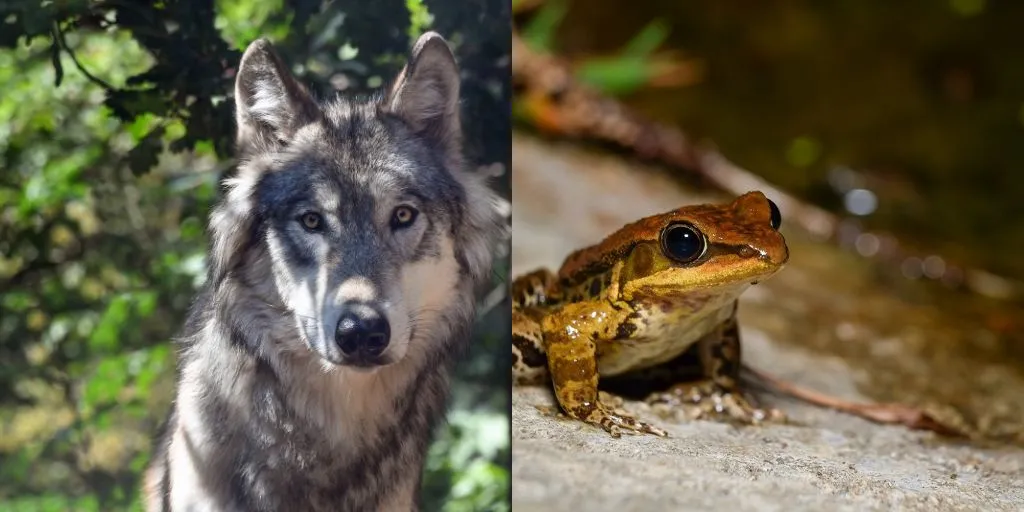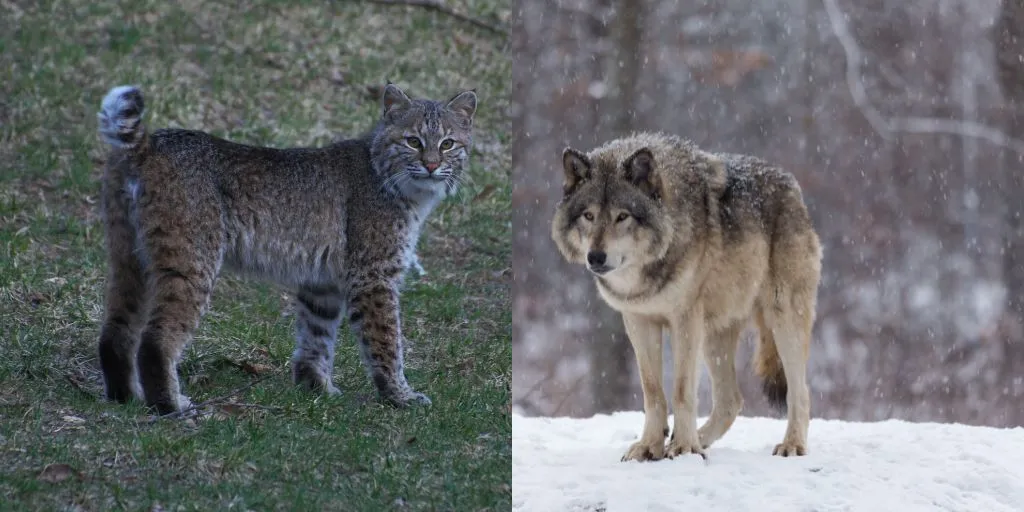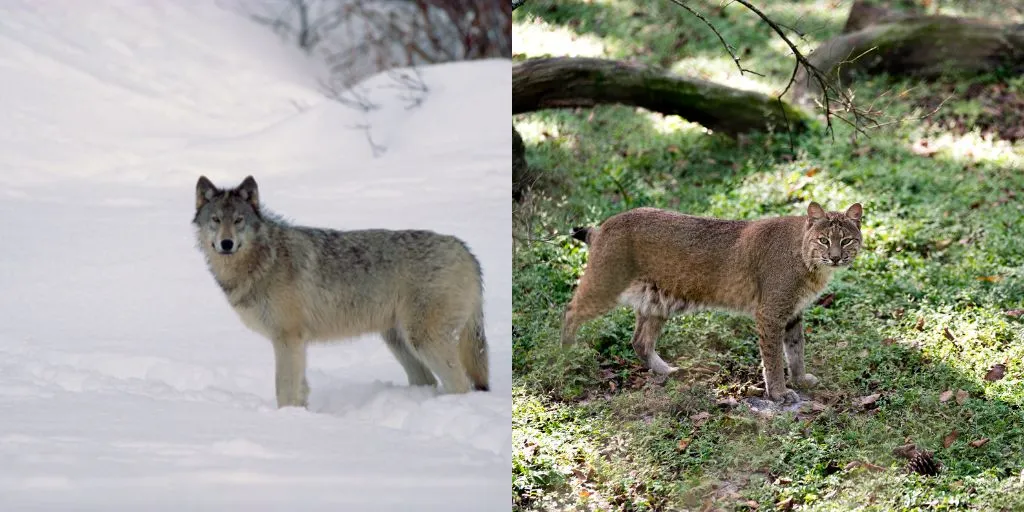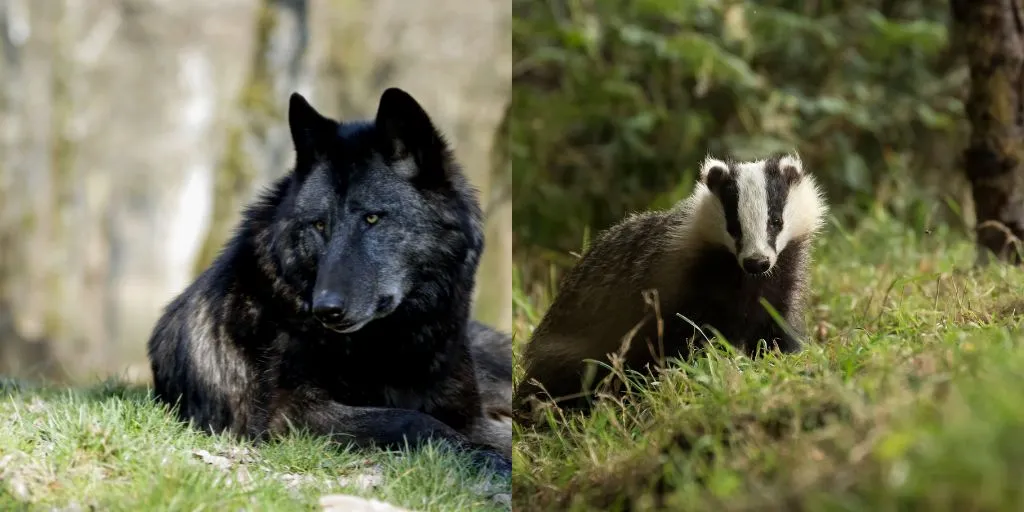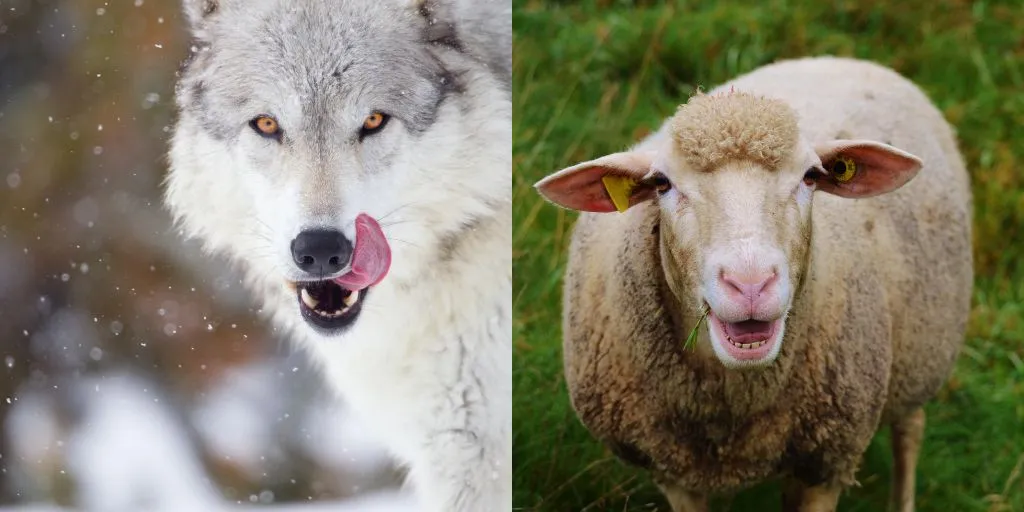When we think of the animal kingdom, the wolf vs cat comparison might not be the first that comes to mind. Yet, this contrast offers a fascinating glimpse into the diverse nature of mammals. Wolves, known for their majestic stature and pack behavior, stand in stark contrast to the more solitary and nimble cats. This article delves into their unique worlds, exploring not just their obvious differences in size and habitat, but also their surprising similarities. Through this exploration, we aim to provide a clear and straightforward understanding of these two remarkable creatures, highlighting their distinct and shared characteristics.
Wolf vs Cat: Differences

Size and Weight

Wolves and cats display a striking contrast in their size and weight. An average wolf can weigh anywhere from 40 to 175 pounds, showcasing their robust and powerful build. In comparison, domestic cats typically weigh between 5 and 20 pounds, highlighting their smaller and more agile form. This significant difference in size and weight underscores the physical diversity within the mammalian kingdom, with wolves being one of the larger predators and cats representing a more compact, versatile hunter.
Fur
The fur of wolves and cats is as different as their sizes. Wolves have a dense, coarse coat designed to protect them from harsh climates. Their fur can vary in color from whites and grays to browns and blacks, often helping them blend into their woodland and tundra habitats. Cats, on the other hand, have softer, shorter fur. Domestic cats exhibit a wide range of colors and patterns, including solids, stripes, and spots, which is less about camouflage and more a result of breeding and domestication.
Habitat and Distribution

Wolves are found in a variety of habitats, ranging from the Arctic tundra to forests and mountains. They are known for their adaptability and are distributed across North America, Europe, Asia, and North Africa. In contrast, cats, especially domesticated breeds, are more versatile in terms of habitat. Originally desert animals, cats have adapted to live almost anywhere, from rural to urban areas, living in close association with humans. This adaptability has led to their widespread presence around the globe.
Dietary Habits
Diet is another area where wolves and cats differ significantly. Wolves are carnivorous and primarily hunt large mammals like deer, elk, and bison. They are pack hunters, utilizing complex strategies to take down prey much larger than themselves. Domestic cats, while also carnivorous, usually hunt smaller prey such as birds, mice, and other small rodents. Their solitary hunting style is more about stalking and pouncing, reflecting their evolution as solitary predators.
Hunting Methods

Cats and wolves have distinct hunting methods that reflect their physical capabilities and natural instincts. Wolves, as pack animals, hunt in groups and rely on teamwork to outmaneuver and overpower larger prey. Their strategy involves chasing and cornering their target, using endurance and coordination. Cats, typically hunting alone, use a stealth approach. They stalk their prey silently, getting as close as possible before launching a swift, precise attack. This difference in hunting styles showcases the unique adaptations each species has developed for survival in the wild.
Communication Methods
Communication among wolves and cats varies significantly, mostly in their sounds and body language. Wolves are known for their iconic howls, which serve to assemble the pack, communicate over long distances, and reinforce social bonds. They also use body language, such as tail positions and facial expressions, to convey emotions and intentions. Cats, on the other hand, communicate primarily through meows, purrs, hisses, and body postures. Their vocalizations are more varied when interacting with humans, and their body language, including ear and tail movements, is crucial for expressing their feelings and desires.
Domestication
The domestication journeys of cats and wolves have taken different paths. Wolves were domesticated thousands of years ago, leading to the diverse breeds of dogs we see today. This process involved selecting wolves that were less aggressive and more sociable towards humans. Cats, in contrast, were likely domesticated for their ability to control pests. Unlike wolves, cats retain more of their wild characteristics, and their domestication is considered to be more of a mutual association than a human-led process.
Lifespan

The lifespans of wolves and cats also differ. Wolves in the wild typically live for 6 to 8 years, though they can live longer in captivity, up to 15 years. Their lifespan is influenced by factors like habitat, availability of prey, and human interactions. Domestic cats have a longer life expectancy, usually living for 12 to 15 years, with some even reaching 20 years or more. Factors influencing their longevity include breed, diet, lifestyle, and healthcare. This difference in lifespan is a reflection of the distinct challenges and environments each animal faces.
Comparing Wolf and Cat
| Aspect | Wolves | Cats |
|---|---|---|
| Size and Weight | Typically weigh 40 to 175 pounds. Larger and more robust build. | Usually weigh between 5 and 20 pounds. Smaller and more agile. |
| Fur | Dense, coarse coat varying in colors for camouflage in natural habitats. | Softer, shorter fur with a wide range of colors and patterns, more influenced by domestication. |
| Habitat and Distribution | Found in diverse environments like forests, mountains, and tundra. Wide geographical distribution across continents. | Originally desert animals, now adapted to various environments including urban areas. Globally distributed, often in close association with humans. |
| Dietary Habits | Carnivorous, hunting large mammals in packs using complex strategies. | Carnivorous, typically hunting smaller prey like birds and rodents, using solitary stalking techniques. |
| Hunting Methods | Pack hunters, relying on teamwork to chase and corner larger prey. | Solitary hunters, employing stealth and pouncing tactics. |
| Communication Methods | Use howls for long-distance communication and body language for close interactions. | Communicate through meows, purrs, hisses, and body language, with a variety of vocalizations for human interaction. |
| Domestication | Domesticated into various dog breeds, with a history of close association with humans. | Domestication more as a mutual relationship with humans, retaining many wild characteristics. |
| Lifespan | In the wild, typically 6 to 8 years, longer in captivity (up to 15 years). | Average lifespan of 12 to 15 years, with some living over 20 years in domestic care. |
Wolf vs Cat: Similarities
Predatory Instincts

Despite their differences, wolves and cats share strong predatory instincts. Both are natural hunters, born with an innate ability to track, stalk, and capture their prey. This instinct is evident from an early age, as both wolf pups and kittens engage in play that mimics hunting behaviors. They learn to hone these skills as they grow, mastering the art of the hunt. This shared predatory nature is a fundamental aspect of their survival, showcasing the deep-rooted hunting heritage present in both species.
Territorial Behavior
Territorial behavior is another common trait between cats and wolves. Wolves establish territories to hunt, mate, and raise their pups. They mark their territory with scents and defend it against intruders, ensuring a safe space for their pack. Cats exhibit similar behavior, though on a smaller scale. They mark their territory with scents, scratches, and sometimes vocalizations, creating a familiar and secure area where they can hunt and rest. This behavior in both species underscores their need for a controlled environment, vital for their survival and well-being.
Night Vision

Wolves and cats both possess exceptional night vision, an adaptation that greatly aids their nocturnal activities. Their eyes are designed to maximize the available light, allowing them to see in conditions that would be challenging for many other species. This ability not only facilitates their hunting at dawn, dusk, or during the night but also plays a crucial role in their ability to navigate and survive in their respective environments. Their enhanced vision is a testament to their evolution as effective nocturnal hunters.
Sharp Senses
Both wolves and cats are equipped with sharp senses that play a crucial role in their survival. Wolves have an exceptional sense of smell, allowing them to track prey and communicate with other pack members over long distances. Their hearing is also highly developed, enabling them to detect sounds that are imperceptible to humans. Similarly, cats have remarkable hearing abilities and an acute sense of smell. Their sight, particularly in low light, is superior as well. These enhanced senses help both wolves and cats in hunting, navigating their environment, and avoiding danger.
Play Behavior
Play is an essential part of life for both wolf pups and kittens. This playful behavior is not just for fun; it serves an important purpose in their development. Through play, young wolves and cats learn vital skills like hunting, defending themselves, and social interaction. They practice stalking, pouncing, and other movements that are crucial for survival in the wild. This play behavior also strengthens their physical abilities and coordination, preparing them for the challenges they will face as adults.
Parental Care
Cats and wolves exhibit strong parental care for their offspring. In wolf packs, both parents, along with other pack members, are involved in raising the young. They teach the pups how to hunt, protect them from danger, and provide socialization within the pack. Cats, while generally more solitary, also show a high level of care for their kittens. Mother cats are attentive, teaching their kittens how to clean themselves, hunt, and understand the world around them. This nurturing behavior ensures that the young are equipped with the skills and knowledge needed to survive independently.
Wolf and Cat Similarities
| Aspect | Wolves and Cats |
|---|---|
| Predatory Instincts | Both have strong predatory instincts, natural hunters from an early age, learning vital skills like hunting through playful behaviors. |
| Territorial Behavior | Both species exhibit territorial behavior, marking and defending their territories with scents and other behaviors. |
| Night Vision | Exceptional night vision in both wolves and cats, aiding in their nocturnal activities and enhancing their ability to hunt in low light conditions. |
| Sharp Senses | Both have acute senses of hearing, smell, and sight which are crucial for their survival, hunting, and navigating their environment. |
| Play Behavior | Playful nature observed in both young wolves and kittens, aiding in learning survival skills and developing physical abilities. |
| Parental Care | Strong parental care exhibited in both species, with nurturing behaviors and teaching of survival skills to their offspring. |
Wolf vs Cat: Who Would Win in a Fight?
A cat would be no match for a wolf. The significant differences in size, strength, and natural behaviors of these two species place them in entirely different categories of predators. Wolves are larger, more powerful, and adapted for hunting and surviving in harsh environments, often as part of a pack. Cats, while agile and skilled hunters in their own right, are much smaller and are not equipped to confront a creature as formidable as a wolf. This disparity is a clear example of how varied the animal kingdom is, with each species evolved to thrive in specific niches and environments.
Conclusion
In exploring the intriguing comparison of wolf vs cat, we have uncovered a world of contrasts and similarities. From the stark differences in size, habitat, and hunting methods to the shared traits of sharp senses and parental care, these animals captivate us with their unique adaptations. This journey through their lives highlights the diversity of the animal kingdom and the specialized roles each species plays in nature. Understanding these aspects not only educates us but also deepens our appreciation for the natural world. We hope this article has provided a clear and engaging insight into the distinct yet parallel worlds of wolves and cats.
Wolf vs Cat – Frequently Asked Questions (FAQ)
Do wolves eat cats?
Yes, wolves can eat cats, but it’s not common. Wolves usually hunt larger prey like deer and elk. They are opportunistic feeders, so if they come across a cat, especially in the wild, they might prey on it. However, wolves eating cats is not a frequent part of their diet.
Are wolves more like dogs or cats?
Wolves are more like dogs than cats. In fact, dogs are directly descended from wolves. They share many behaviors and physical traits with dogs, like pack mentality and certain communication methods. Cats are quite different in their solitary nature and hunting techniques compared to both wolves and dogs.

